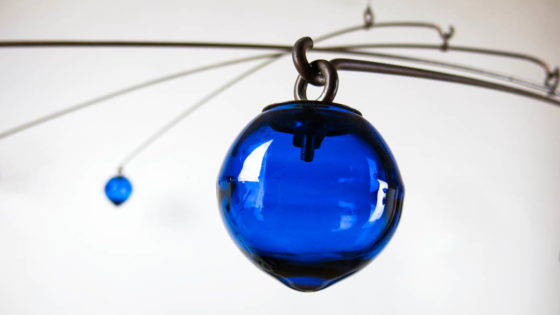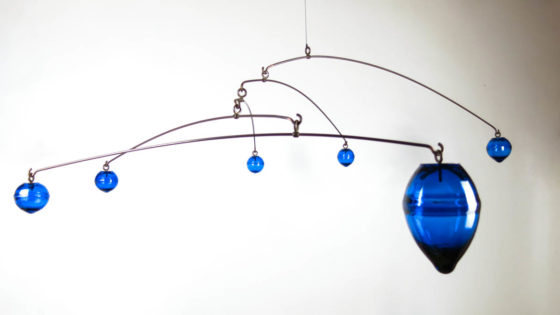Phase Equilbria was derived as a visual response to the scientific abstract that follows below. The materials I chose to work with are predominantly the same as in the experiment, and express the same ideas but in a very different way, while the form was conceived to come from an imaginative molecular world based on visual geometry. The copper rod, being a excellent conductor, is indicative of the transfer of matter or energy between the glass components. The glass, itself an insulator, contains both copper and cobalt oxide, creating an electric blue hue. The kinetic nature of the sculpture moving through space, and the fact that each element is dependently balanced on the next, creates is own sense of equilibrium in air.
Phase equilibria in the system cobalt oxide/copper oxide in air
(Phase equilibrium is the state of balance between two phases of a molecule. It occurs when the transfer of matter or heat energy from one phase to another phase is equal to the rate of transfer of matter or heat energy in the reverse direction.
The driving forces of phase equilibrium are equal during phase equilibrium. The three different phases of compounds are solid, liquid and gas. To change phases, a compound must gain or lose energy in the form of matter or heat. Compounds can change from one phase to another if enough energy is applied to the system.)
A phase diagram is proposed for the system cobalt oxide/copper oxide showing the phases which are stable in air at temperatures between 600 and 1200°C. From X-ray analyses of quenched samples and from high-temperature X-ray analyses the occurrence of the following phases was established: a cubic spinel phase CuxCo3−xO4 () ⩽ x ⩽ 0·3), a cubic rock-salt phase CuyCo1−yO (0 ⩽ y ⩽ 0·39), a phase CuyCo1−yO (0·63 ⩽ y ⩽ 0·68) with a specific structure, a liquid phase, the phase Cu2O and the phase CuO. The oxygen content of most of the quenched samples consisting of a single phase was slightly higher than that given by the above formulae. The position of the phase boundaries and the phase transitions was further investigated by differential thermal analyses and by microscopic observations on quebched samples as well as on samples at high temperatures.
The isomorphism of the compound Cu2CoO3 (y = 23) and the mineral güggenite, Cu2MgO3, is discussed.
F.C.M. Driessens a, b, ∗, G.D. Rieck a, b, H.N. Coenen a, b
aPhilips Research Laboratories, N.V. Philips Gloeilampenfabrieken, Eindhoven, Netherlands
bLaboratory of Physical Chemistry, Technical University, Eindhoven, Netherlands
Received 14 September 1967, Available online 16 May 2003
Date: 2014
Dimensions: L: 2 meters W: 2 meters H: 1.5 meters
Materials: Solid Copper rod, copper plate, copper wire, soda-lime glass with copper oxide, cobalt oxide.

